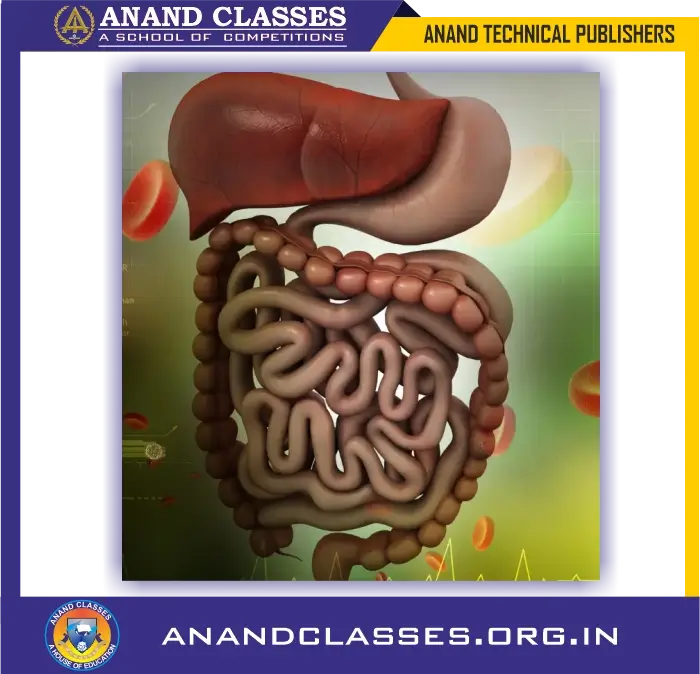ANAND CLASSES Study Material and Notes to learn about Holozoic Nutrition in Class 10 Science Biology and NEET Foundation. Understand its stages, examples, multiple-choice questions (MCQs), conceptual questions with answers, worksheets, and test papers for better exam preparation.
Holozoic Nutrition
Holozoic nutrition is a mode of nutrition in which organisms take in solid food, digest it internally, and absorb the required nutrients while eliminating waste materials. This type of nutrition is observed in most animals, including humans. The process is crucial for growth, energy production, and overall survival.

organism
Organisms that follow holozoic nutrition consume complex organic food, which may be derived from plants (herbivores), animals (carnivores), or both (omnivores). This process involves various stages, ensuring the breakdown of food into simpler, usable forms.
Stages of Holozoic Nutrition
Holozoic nutrition occurs in five main stages:
- Ingestion: The process of taking food into the body. In humans, this happens through the mouth, where food is chewed and mixed with saliva to form a bolus.
- Digestion: The breakdown of complex food substances into simpler, absorbable forms using mechanical and chemical processes.
- Mechanical digestion involves physical breakdown (e.g., chewing in the mouth, churning in the stomach).
- Chemical digestion involves enzymatic actions (e.g., amylase in saliva breaking down starch, pepsin in the stomach breaking down proteins).
- Absorption: The transfer of digested nutrients from the digestive tract into the bloodstream or body cells. This occurs mainly in the small intestine, where villi and microvilli increase the surface area for nutrient absorption.
- Assimilation: The utilization of absorbed nutrients for energy production, growth, and cell repair. Glucose is used for energy, proteins for muscle development, and fats for energy storage.
- Egestion: The elimination of undigested and unabsorbed food materials in the form of feces through the anus.
Examples of Holozoic Nutrition
Holozoic nutrition is found in various organisms, such as:
- Herbivores: Cattle, deer, giraffes (consume plant material)
- Carnivores: Tigers, lions, frogs (consume animal flesh)
- Omnivores: Humans, bears (consume both plants and animals)
- Unicellular organisms: Amoeba, Paramecium (engulf food through phagocytosis)
Conceptual Questions with Answers
- What is holozoic nutrition?
- Holozoic nutrition is a type of nutrition in which organisms consume solid food, digest it internally, absorb nutrients, and eliminate waste. Examples include humans, tigers, and Amoeba.
- How does holozoic nutrition differ from other types of nutrition?
- Holozoic nutrition: Involves ingestion, digestion, absorption, assimilation, and egestion of solid food.
- Saprotrophic nutrition: Involves decomposing dead matter externally and absorbing nutrients (e.g., fungi, bacteria).
- Parasitic nutrition: Involves deriving nutrients from a living host (e.g., tapeworms, lice).
- Autotrophic nutrition: Involves synthesizing food using sunlight and inorganic substances (e.g., plants, algae).
- Why is digestion necessary in holozoic nutrition?
- Digestion breaks down large food molecules into smaller, absorbable molecules that the body can utilize for energy, growth, and repair.
Multiple Choice Questions (MCQs)
- What is the first step in holozoic nutrition?
- a) Digestion
- b) Ingestion
- c) Absorption
- d) Egestion Answer: (b) Ingestion Explanation: Ingestion is the initial step where food is taken into the body.
- Where does most of the nutrient absorption occur in humans?
- a) Stomach
- b) Liver
- c) Small intestine
- d) Large intestine Answer: (c) Small intestine Explanation: The small intestine, with its villi and microvilli, is the main site of nutrient absorption.
- Which organism does NOT follow holozoic nutrition?
- a) Amoeba
- b) Cow
- c) Mushroom
- d) Tiger Answer: (c) Mushroom Explanation: Mushrooms obtain nutrients by decomposing organic matter externally (saprotrophic nutrition).
Do You Know?
- Amoeba engulfs its food using pseudopodia in a process called phagocytosis.
- Herbivores have specialized teeth for grinding plant material, while carnivores have sharp teeth for tearing meat.
- Humans secrete about 1.5 liters of saliva daily, which aids in digestion.
- The small intestine in humans is about 6 meters long, maximizing nutrient absorption.
- Frogs use their sticky tongue to capture insects, aiding ingestion.
Worksheet
Fill in the Blanks
- The process of taking in food is called __________.
- The breakdown of food into simpler substances is called __________.
- The undigested food is eliminated from the body through __________.
- __________ is an example of an organism that follows holozoic nutrition.
Match the Following
| Column A | Column B |
|---|---|
| Ingestion | Taking in food |
| Digestion | Breaking down food |
| Absorption | Nutrient uptake by body cells |
| Assimilation | Utilizing nutrients for energy |
| Egestion | Removal of waste |
Test Paper (Marks Distribution: 10 Marks)
Section A: MCQs (2 Marks)
- Which process occurs first in holozoic nutrition?
- a) Absorption
- b) Ingestion
- c) Digestion
- d) Egestion [1 Mark]
- In which part of the human body does digestion start?
- a) Stomach
- b) Small intestine
- c) Mouth
- d) Large intestine [1 Mark]
Section B: Short Answer Questions (4 Marks)
- Define holozoic nutrition with an example. [2 Marks]
- Explain the role of the small intestine in holozoic nutrition. [2 Marks]
Section C: Long Answer Question (4 Marks)
- Describe the stages of holozoic nutrition in detail with suitable examples. [4 Marks]
Important Points for Quick Revision
- Holozoic nutrition involves five steps: ingestion, digestion, absorption, assimilation, and egestion.
- Humans, most animals, and Amoeba follow holozoic nutrition.
- Digestion in humans starts in the mouth and continues in the stomach and intestines.
- Herbivores, carnivores, and omnivores all exhibit holozoic nutrition with different dietary adaptations.
- Waste materials are eliminated through egestion, ensuring a clean internal environment.
🔷 Best Coaching Center for IIT-JEE, NEET, and Foundations
🔹 ANAND CLASSES – The best coaching institute for JEE, NEET, and Class 11-12 Foundations.
🔹 Buy complete study material at 👉 https://publishers.anandclasses.co.in/
🔹 Proprietor: NIRMAL ANAND Educations
🔹 Written by: Neeraj Anand
🔹 Published by: Anand Technical Publishers under Anand Classes
📞 Contact: +91-9463138669
📧 Email: anandclasses1996@gmail.com



